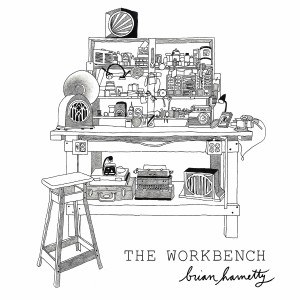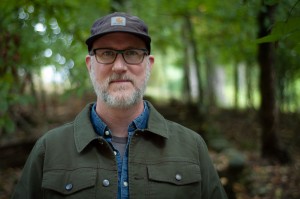
Artist
IMAGES: To download, click above. Photo creditto Jennifer Harnetty.
Brian Harnetty
Over the past two decades, Columbus, Ohio, based artist and composer Brian Harnetty has been lost in sound: archives, field recordings, turntables, tape machines, radios, orchestras, toy and junk instruments, and his own chamber ensemble have all been featured in his work. At the same time, he has used the practice of listening as a way to foster social change, and as a means to understand places and people from Appalachia and the Midwest.
During these years, Harnetty developed an interdisciplinary approach to music and sound art. He brings together in-depth ethnographic research and community outreach—over long stretches of time—with the ghosts of sampled archives and his own mix of experimental, ambient, electronic, and folk music. Past and present bleed into one another to spark new music and imagine new futures.
Harnetty’s most recent album, Words and Silences (2022), was a portrait of monk, activist, and writer Thomas Merton. It explored archival recordings of Merton and revealed his intimate, interior voice. Words and Silences received much critical acclaim, including 5/5 stars from Mojo Magazine, and was on many “Best of 2022” lists, including The Wire, Allmusic, Mojo, and Aquarium Drunkard.
Following this critical success, The Workbench is Harnetty’s most personal work to date: a sonic portrait of his father, Paul. The piece is a reflection on time, filial connections, life and death, and the power of inherited objects.
Growing up in Appalachian Ohio, Harnetty’s father repaired mechanical things: watches, clocks, typewriters, radios, and record players. His patience and curiosity with these modest and everyday items — combined with an ability to repair seemingly anything — gave him a mythical status in the family.
After his father’s death, Harnetty inherited these things, along with a workbench. Harnetty began to think of the objects as conduits between past and present, living and dead. He began to ask: are there sonic traces of a person embedded in these collected, repaired, and loved objects? And do the objects have their own agency, which we can activate and listen to?
Featuring members of the Unheard-Of Ensemble alongside Harnetty’s piano, the music of The Workbench is both elegiac and curious, slowly building momentum over the course of a dozen minutes. Throughout, we hear voicemails from Harnetty’s father, where his everyday questions and statements become both ambiguous and poignant. At times, we hear recordings of some of the repaired objects: watches, a brief radio program, static, and a slowly turning music box.
At the end, a recording of Harnetty’s father calmly sleeping and breathing in hospice is raw, intimate, and dignified. It lends a gravity to the piece, and is both shocking and perfectly ordinary, too. Despite the extremely personal nature of the piece, the recordings of Harnetty’s father become archetypal: sounds that connect to everyone’s experiences. As we listen to him moving through the stages of life and death, we are confronting the fundamental issues of what it means to be human, and mortal.
The second track on The Workbench EP is a flip side to the same coin. As an all-instrumental version of the piece, it remixes the material, adding additional instruments. The silences where Harnetty’s father’s voice once occupied now offer quiet moments of reflection and repose.
The project’s video, filmed by Kevin Davison and with Harnetty’s direction, methodically explores the workbench. We see tools, radios, speakers, a typewriter, and many small collections of things. The objects are arranged just so; they reveal how one’s personal workspace can become a collection or even an archive of everyday objects imbued with meaning and aesthetic pleasure.
The Workbench is both portrait and memorial. It directly uses the themes and methodologies that Harnetty’s work is concerned with: lives of everyday people, contemplative listening, found sounds, and interdisciplinary storytelling. Perhaps most importantly, it pays careful attention to seemingly trivial details of everyday life. It shows how attentive listening might reveal something to us right now: a way to think deeply about each other, and work toward healing the people and places where we live.


